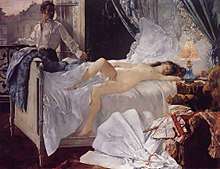Henri Gervex
Henri Gervex (Paris 10 December 1852 – 7 June 1929) was a French painter who studied painting under Alexandre Cabanel, Pierre-Nicolas Brisset and Eugène Fromentin.[1][2]

Biography
Early years
He was the son of Joséphine Peltier and Félix Nicolas Gervex, a piano maker. When he was 15, a friend of the family helped him get admitted to the atelier of Pierre-Nicolas Brisset. Three years later, he served in the 152nd Battalion of the National Guard. In 1871 he was accepted into the École des Beaux-Arts in the studio of Alexandre Cabanel, where he studied for five years along with Jean-Louis Forain, Fernand Cormon, and Eugène Damas, a landscape painter. He also apprenticed himself to the Orientalist painter Eugène Fromentin.
Debut

His early work belonged almost exclusively to the mythological genre, which served as an excuse for the painting of the nude, but not always in the best of taste. His Rolla of 1878, based on a poem by Alfred de Musset, was rejected by the jury of the Salon de Paris for immorality,[1] since it depicted a scene from the poem of a naked prostitute after having sex with her client.

Gervex was one of many lovers entertained by the famous courtesan Valtesse de La Bigne. Their relationship was long and deep, with Gervex including the golden haired beauty in his piece of art called The Civil Marriage of 1881; here Valtesse De la Bigne is dressed from head to toe in blue, her favourite colour as it symbolises royalty, standing beside a dark haired man with a moustache. Another painting of La Bigne inspired Émile Zola in the creation of his heroine for the novel Nana, and Gervex himself was the model for the character of an opportunistic painter who appears in Zola's novel L'Œuvre (The Work [of Art], 1886).[3]
Gervex afterwards devoted himself to representations of modern life and achieved signal success with his Dr Péan at the Salpétrière ("The Operation"), a modernized paraphrase, as it were, of Rembrandt's Anatomy Lesson.[1][4]
Career

He was entrusted with several important official paintings and the decoration of public buildings. Among the first are The Distribution of Awards (1889) at the Palais de l'Industrie, The Coronation of Nicolas II, The Mayors' Banquet (1900), and the portrait group La République Française; and among the second, the ceiling for the Salle des Fêtes (ballroom) at the Hôtel de Ville, Paris, and the decorative panels painted in conjunction with Emile-Henri Blanchon for the mairie of the 19th arrondissement, Paris. He also painted, with Alfred Stevens, a panorama, The History of the Century (1889). The Musée du Luxembourg holds his painting Satyr Sporting with a Bacchante, as well as the large Members of the Jury of the Salon (1885). Other pictures of importance, besides numerous portraits in oils and pastel, are The Birth of Venus, Communion at Trinity Church, Return from the Ball, Diana and Endymion, Job, Civil Marriage, At the Ambassadeurs, Yachting in the Archipelago, Nana and Maternity.[1][5]
In 1913 he was elected to the Académie des Beaux-Arts.

Works
- Henri Gervex's works
 Café Scene in Paris, 1877
Café Scene in Paris, 1877 Cinq Heures Chez Paquin
Cinq Heures Chez Paquin A soirée
A soirée Un soir de grand prix au pavillon d'Armenonvill
Un soir de grand prix au pavillon d'Armenonvill
Students
- Jacques-Émile Blanche (1861-1942)
- Georges Dubosc (1854-1927)
- Henry Gerbault (1863-1930)
Notes
- Chisholm 1911, p. 908.
- Benezit Dictionary of Artists
- Editorial note appearing in: Henri Mitterand, notice pour l'édition de L'Œuvre d'Émile Zola dans la collection Folio classique, Gallimard, 1983, p. 435.
- "Henri Gervex". www.artrenewal.org.
- RKD
References

External links
| Wikimedia Commons has media related to Henri Gervex. |